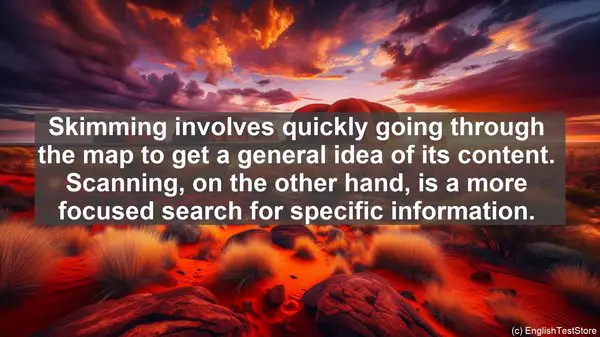Introduction: The Importance of Map Questions in IELTS
Welcome to our IELTS preparation series. Today, we’re focusing on map questions, which are a common component of the IELTS exam. These questions not only test your ability to understand maps but also assess your overall comprehension and inference skills. By mastering these techniques, you’ll not only improve your map question performance but also enhance your overall IELTS score.
1. Familiarize Yourself with Map Symbols
Maps are filled with symbols that represent various features like buildings, roads, and natural elements. Before attempting any map question, it’s crucial to understand these symbols. Spend some time studying a map’s legend, which provides a key to these symbols. This initial step will prevent confusion and ensure accurate interpretation of the map.
2. Pay Attention to the Scale
Maps have a scale that indicates the ratio between the map and the actual distance. This scale is often represented as a line with markings. By understanding the scale, you can estimate distances between different locations accurately. This skill is particularly useful when answering questions that involve calculating distances or determining the nearest landmark.
3. Analyze the Compass Directions
The compass on a map indicates the cardinal directions: north, south, east, and west. Understanding these directions is crucial for interpreting map features. For instance, if a question asks about the location of a particular feature relative to another, your knowledge of compass directions will be invaluable. Regular practice with compass directions will make it second nature to you.

4. Use Contextual Clues
Sometimes, a map question may not provide explicit information. In such cases, you can rely on contextual clues. For example, if a question mentions a river and a bridge, you can infer that the feature being asked about is likely to be near the river or the bridge. These contextual clues, when used effectively, can help you make educated guesses and arrive at the correct answer.
5. Break Down Complex Maps
Maps can be intricate, with multiple layers of information. When faced with a complex map, it’s essential to break it down into smaller sections. Start by identifying the main landmarks or features. Then, gradually move on to the smaller details. This systematic approach will prevent overwhelm and ensure you don’t miss any crucial information.
6. Practice Skimming and Scanning
Time management is crucial in the IELTS exam. Skimming and scanning are two techniques that can significantly improve your efficiency. Skimming involves quickly going through the map to get a general idea of its content. Scanning, on the other hand, is a more focused search for specific information. Regular practice of these techniques will enhance your speed and accuracy.
7. Highlight Keywords
When reading the question, it’s helpful to identify and highlight keywords. These are the words that carry the most significance and provide clues about the information you need to find on the map. By highlighting them, you’ll be able to quickly locate the relevant details, saving you time and reducing the chances of errors.
8. Use the Process of Elimination
In multiple-choice map questions, the options provided can sometimes be confusing. In such cases, the process of elimination can be a valuable strategy. By carefully analyzing each option and eliminating the ones that are clearly incorrect, you increase your chances of selecting the right answer, even if you’re unsure about it initially.
9. Review Your Answers
While it’s essential to manage your time effectively, it’s equally important to allocate a few minutes at the end for reviewing your answers. During this time, double-check your responses, ensuring they are accurate and in line with the question. This final review can help catch any errors or oversights, potentially improving your overall score.

10. Practice, Practice, Practice
As with any skill, practice is key to mastery. Set aside dedicated time for solving map-related questions. There are numerous resources available, including past IELTS papers and online practice tests. The more you expose yourself to different map scenarios, the more comfortable and confident you’ll become in tackling them.
